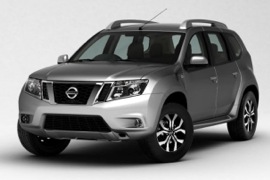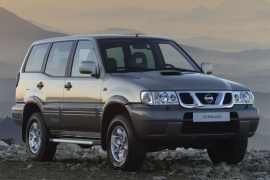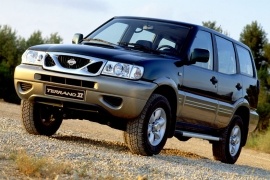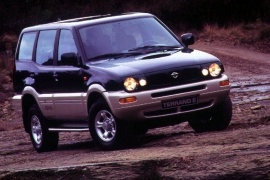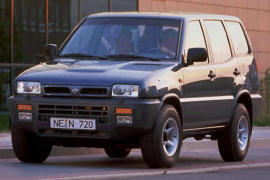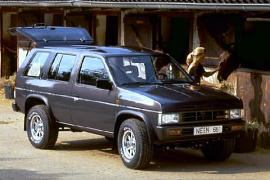NISSAN Terrano 5 Doors Models/Series Timeline, Specifications & Photos
First production year: 1990
Engines: Diesel, Gasoline
Body style: SUV (Sports Utility Vehicle)
The Terrano name was successful in the European and other markets around the world, but it was axed once the Japanese carmaker went into an alliance with Renault. But, in 2013, they brought it back.
Being into an alliance with Renault brought some advantages to Nissan. Even though the Japanese carmaker was an expert in the 4x4 sector, it didn't succeed to make affordable, unibody, SUVs. In Europe, the best SUV recipe was the Dacia Duster, which was sold on some other markets as the Renault Duster. Nissan engineers took that compact SUV and reshaped it in the form of the 2013 Terrano.
Nissan started to work on the car by changing the front fascia to a more recognizable grille from a Nissan Patrol with chromed slats and bigger, angular headlights. On the side, a subtle line was drawn on the bottom of the doors. The liftgate featured an additional light unit on it, to complement the fixed to the body taillights.
Inside the car, there was the same adequate room for a compact SUV vehicle. Five adults could fit inside the car. The multimedia unit was different than the one found on the Renault/Dacia Duster.
Under the hood, the Terrano featured the same engines as the Duster, with front or all-wheel-drive systems. The all-wheel-drive versions featured independent suspensions on all four corners, while the front-wheel drive version was fitted with a twisting beam in the back.
The second generation of the European Nissan Terrano was introduced to the market in 1996 and it was a joint development program with Ford.
While the Ford Maverick was withdrawn, the Terrano II continued its journey on the market until 2006.
For the European version, the Nissan Terrano II received a body-on-frame platform, with a front independent suspension and a rear axle. It was not the hard-core off-road specialist as its bigger brother Patrol, but it was praised for its comfortable ride on pavement. Its handling was not its biggest advantage.
From the outside, the ascending roofline was needed to offer more headroom for the rear passengers, but it was the same idea introduced by Land Rover Discovery. The Terrano II featured an ascending beltline. In 2002 it went through a final facelift that brought better engines and a steering wheel carry-over from the Nissan Primera.
Inside, the Terrano II was available with up to seven seats, the last row being installed in the trunk area. The folding bench was wide enough to fit two slim adult passengers, but with limited hip and legroom. The dashboard featured a car-like layout, with a center stack and a high-mounted audio system.
Under the hood, there was the same 2.7-liter diesel engine, but a new, 3.0-liter unit was introduced. It was the same used for its bigger brother, the Nissan Patrol. All versions were part-time 4x4 with a low-range gear and the standard transmission was a 5-speed manual. Depending on the market, an option for 4-speed automatic was on the options list.
In 2000, Nissan upgraded the Terrano's second generation, continuing the production of its European-oriented SUV, while its partner Ford pulled the plug on the Maverick.
Creating a common vehicle was a good idea for both automakers. Still, the Japanese brand was more successful than its blue-oval partner. Both vehicles were produced in Nissan's factory in Barcelona in 1993, but immediately customers started to ask for the Terrano II more than for the Maverick. By 1999, it was obvious to the American brand that its vehicle struggled to keep up with the sales. Since in 2000, the Euro 3 came into force, Ford considered that it didn't worth it to continue and stopped the production.
The 2000 model featured a new front fascia with a smiling chromed grille. Nissan also added new headlights, sporting a design inspired by Terrano's bigger brother, the Patrol. In addition, the bumper was also reshaped but still sported unpainted areas to not get affected by shopping carts or bushes. From its profile, the five-door SUV featured plastic panels and molds on the wheel arches that provided protection for the said situations.
Inside, the Japanese automaker installed a new, multi-function steering wheel carried over from the Primera. Thus, the driver could've adjusted the sound system's volume without lifting their hands from the wheel. Moreover, since the vehicle was built on a long wheelbase chassis, those seated in the back had enough legroom. In addition, the automaker offered a set of side steps that eased the ingress and egress of the vehicle.
Due to the new catalytic converter, the new gasoline engine lost one horsepower compared to the Euro 2 Terrano. In addition, the automaker kept the turbo-diesel powerplant on its offer. Both versions featured standard with five-speed manuals and a low-range transfer case.
Nissan introduced a mid-life cycle refresh for its European SUV Terrano II built in Spain along with the Ford Maverick.
The Japanese carmaker managed to grow in the hearts of the European and British car buyers that were looking for a family-oriented SUV. Its comfortable front independent suspension and roomy interior, combined with fuel-efficient engines, were well received by the market. After just three years since it was introduced, it received a mid-life cycle refresh meant to improve the engines and made them Euro 2 compliant. The new emission rule was mandatory from January 1997.
From the outside, the main difference was at the front, where the car adopted four round headlights instead of the rectangular ones used on the previous model. Also, the grille got wider gaps to allow better cooling needed, especially in rough terrain. Depending on the trim level, the Terrano II featured plastic side moldings to protect the doors and panels from scratches and bush-markings. Even though its longer wheelbase and cabin allowed the carmaker to move the spare-wheel inside the trunk, Nissan chose to leave it attached to the rear on a separate cradle.
Some visual changes were on the interior, where Nissan mounted a new dashboard and instrument cluster. The carmaker introduced an LCD for the odometer on top of the instrument panel. An important addition was the airbag introduction for both front occupants. Nissan even tried to offer more comfort and luxury-inspired features such as the wood-trims on the center stack and door panels.
Under the hood, Nissan installed a 2.7-liter turbo-diesel engine, which gained 24 hp over its predecessor. It was the main engine choose by the European customers. On the other hand, the 2.4-liter gasoline unit lost six horsepower due to a catalytic converter.
Nissan and Ford decided to build an SUV especially for the European customers in a Spanish factory, and the result was the Terrano II/ Maverick lineups.
In 1993, Nissan unveiled the SUV continuing the Terrano name. It was received with great expectations since the carmaker was already known for its offroad vehicles. That helped Nissan sells more cars than Ford of Europe. It also used different trims and upholstery inside the Terrano II cabin.
Nissan's designers chose to install rectangular headlights on the Terrano II and a slim grille between them, which sported the company's badge on its upper side. On the sides, depending on the options, a set of side steps were available. Strangely though, the carmaker didn't offer side moldings to protect the bodywork from bushes and minor scratches. Its ascending beltline looked softer than on the three-door version since it started on the rear doors. Even though its longer wheelbase and cabin allowed the carmaker to move the spare wheel inside the trunk, Nissan chose to leave it attached to the rear on a separate cradle.
Nissan offered the Terrano II with a five or seven-seat option, with jump-seats in the trunk. Thanks to the folding second and third row of seats, the car could get up to 1,900 liters (67 cu-ft) of cargo behind the front seats. Depending on the trim level, the carmaker fitted either a cloth upholstery or a leather-clad interior.
The vehicle was built on a chassis, with a front independent suspension and a five-link rear axle. It was powered either by a 2.4-liter gasoline engine or a 2.7-liter turbodiesel. All versions were part-time 4x4 with a low-range gear, and the standard transmission was a 5-speed manual. Depending on the market, an option for a 4-speed automatic was on the options list.
Four years after launching the Pathfinder on the U.S. market, Nissan thought that it might be a good idea to sell it in Europe as well and introduced it on the Old Continent in 1989 as a 1990 model year.
Thanks to the compact sizes of the Pathfinder/Terrano, the Europeans didn't have a problem driving it on narrower streets or using it in cities. At the front, the flat grille sported a pair of horizontal slats and was flanked by squared headlights. While the slim bumper didn't provide too much confidence in its ruggedness, it was useful to host the blinkers and the hanged foglights, when fitted, underneath it. Even though the Terrano was based on the WD21 platform shared with its three-door sibling, it wasn't longer. Nissan's design department had a brilliant idea to conceal the door handles from the rear doors into the C-pillar, thus creating the idea of a two-door pickup with a topper on it. Yet, to provide enough trunk space, the carmaker chose to install the spare wheel on a cradle behind the tailgate.
Inside, the automaker was stuck with the same old-looking, squared dashboard design. While it was neat and functional, it wasn't everybody's cup of tea. Also, the HVAC controls were mounted upper on the center stack than the stereo, which was not a good idea. Yet, there was room enough for five adult passengers, and thanks to the folding rear seats, it was good on camping trips too.
Unlike its American sibling that was fitted with a 3.0-liter V6 gasoline unit, the Terrano also received a 2.7-liter turbo-diesel powerplant, which was far more fuel efficient. Power went to the rear or in all corners via a five-speed manual and a two-speed transfer case. In addition, a four-speed automatic was available.
